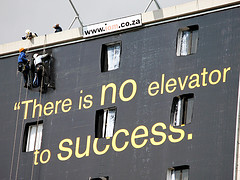Deprecated: Function create_function() is deprecated in
/home/metcomp/smm/wp-content/plugins/wp-spamshield/wp-spamshield.php on line
1858
 The Getting Things Done Yahoo Group is having an interesting discussion about Control mechanisms.
The Getting Things Done Yahoo Group is having an interesting discussion about Control mechanisms.
Without control mechanisms of some type in place, doesn’t that pretty much leave you in the lap of the gods so to speak?
In my response I outlined 8 steps to being productive. I try to instill control, yet give the flexibility to be creative and maximize your day. It all starts with thinking first.
Preplanning
At the end of each day you should plan your next day. This may be an outgrowth of your weekly review- or as it should be called “The Weekly Preview”. Depending on your type of job think this is impossible, but it’s not. For example, if you are in constant crisis mode most of your plan may be thrown out each morning but your plan should be to get the bottom of the crisis so you can move past it.
First you’ll need to determine the most important tasks (MITs) that need to be done the next day. Don’t count daily maintenance tasks like following up and checking email as part of this. If there are 20 things you need to get done then you’re just setting yourself up for failure (unless they aren’t big and you can batch a bunch together and count it as one of your MITs).
Don’t try to fill your full day with MITs- these are just the choices to get you started. Just pick the 1-5 items that you want to get done the next day (keep it 3 or less ideally). Start with items that MUST get done (e.g. deadlines) – that if you don’t do it you’ll need to stay late. Also check your calendar of how much time you’ll have. The more scheduled time you have the less MITs you should plan. Then if you still have open slots, pick tasks that will be best for you for the long term while balancing for project size: smaller projects go first. A better idea is to use layering to cut your most strategic projects into small attainable parts so they don’t get pushed off and are the smaller projects that you end up doing.
At the end of this process you’ll have you a few MITs and a bunch of other tasks. Dont worry these other tasks will still get done.
Here’s how to schedule your productive day:
1. Most Important Tasks
Start with your first MIT first thing when you get in, before you check email or process your other in boxes. Much has been written about the advantages of starting the day early. Getting in early to do a MIT can set your day in the right track. Even if you cant get in early get to your first MIT as soon as possible.
2. Process
When you start processing your in boxes do the quick tasks on the spot. GTD has a two minute rule that in itself can trim items off your to do list before they get there. I would expand this to a 5 minute rule (or even 10) for the following scenarios:
a) Lots of small tasks
Your to do lists are long enough, if you keep having to add 5-10 minute tasks to it and cycle through 5-10 minute tasks every time you want to pick a task you’re just wasting time and energy. Further if you know someone will spend 5 minutes following up on these tasks then it wastes more time. Get it done. Once it’s done it’s no longer on your list and out of your mind. This is part of the reason you didn’t over schedule yourself, so you can properly react to your incoming tasks. If you have a lot of these tasks then you may decide to schedule a MIT for the next day to get rid of the 10 minute tasks.
b) Offensive Opportunities
Sometimes if you take care of a task quickly you can create good will. This can be used with prospects, customers and bosses.
c) Preparation
If you receive information about a task that doesn’t have an immediate deadline don’t just file it away, look at it first. Jot down a quick outline of your thoughts. You may create a few Next Actions right away. Pay special attention to missing information, you’ll want to email people quickly so they have maximum time to do proper research. Seek to get project scope/deadline early on- this will save you lots of rushing at the deadline.
d) Soaking Time
Give yourself time to be creative by figuring what needs to be done and let your mind work in the background. Again an outline helps here. Then let your brain work in the background. You can even schedule a reminder for your self in a few days to jot down a few more notes.
3. Maintenance tasks
These are the small daily tasks you need to do like ticklers/follow ups. Be sure that you go through your follow up list.
4. More MITs
Spend uninterrupted time on your next MIT. Set your environment so you can get in the zone.
5. More Processing/Breaks
Breaks are good for you- just don’t take it to an extreme. Two to five minutes every hour gives you time to rejuvenate. After a break you can switch gears to the next MIT or processing time.
You should schedule processing time at key intervals of your day. Different jobs have different requirements. I would recommend once in the morning, once before and after lunch and one last time before you leave.
6. Context
You can only do certain tasks in certain places. In your Preplanning, you may have scheduled yourself to be in a place to do one of your MITS (e.g. a meeting). Be sure that you think through where you’ll be so you can have a productive time during the transitions e.g. as you wait. Trace your steps through transitions. If you find yourself in your car be sure to have your cell phone or something appropriate to listen to.
7. Seize The Day
After you’re done with your MITs for the day, you pick your next task by gaugin the time available/energy available. If you’re ambitious you can find another MIT, otherwise just slice and dice and get your task list down.
8. Start Planning
Before you leave for the day preplan (see the first section) the next day to get it going on the right foot.
As you see this schedule is rigid but allows flexibility. You may be going along one day doing your tasks and realize that the current task can be ATEd (automated, eliminated or delegated). If you spend some extra time now you’ll receive greater benefits in the future. You can then decide to schedule it for the next day or push off your next MIT to the next day and do the automation on the spot.
I used this flexibility to write this blog post. I started the base of this blog post as a reply to the conversation but as I kept writing I realized it was getting lengthy as there were some concepts I wanted to explain. Some may have quit and said there’s too much to write and not enough time allocated. Instead I took the extra time and it became the foundation for the blog post that I wrote later.
Have a productive day!
Photo credit: Maik Radke


 Michael Jordan can beat you at a game of basketball without trying. Donald Trump can find a better real estate deal than you with just a few calls.
Michael Jordan can beat you at a game of basketball without trying. Donald Trump can find a better real estate deal than you with just a few calls. 